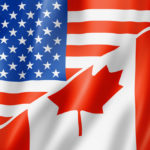By Michael J. Wiener, Michael James on Money
Special to the Financial Independence Hub
When it comes to investing, we should keep things as simple as possible. But we should also keep costs as low as possible. These two goals are at odds when it comes to choosing between Canadian and U.S. exchange-traded funds (ETFs). However, there is a good compromise solution.
First of all, when we say an ETF is Canadian, we’re not referring to the investments it holds. For example, a Canadian ETF might hold U.S. or foreign stocks. Canadian ETFs trade in Canadian dollars and are sold in Canada. Similarly, U.S. ETFs trade in U.S. dollars and are sold in the U.S. Canadians can buy U.S. ETFs through Canadian discount brokers but must trade them in U.S. dollars.
Vanguard Canada offers “asset allocation ETFs” that simplify investing greatly. One such ETF has the ticker VEQT. This ETF holds a mix of Canadian, U.S., and foreign stocks in fixed percentages, and Vanguard handles the rebalancing within VEQT to maintain these fixed percentages. An investor who likes this mix of global stocks could buy VEQT for his or her entire portfolio without having to worry about currency exchanges. It’s hard to imagine a simpler approach to investing.
Investors who prefer to own bonds as well as stocks can choose other asset-allocation ETFs offered by Vanguard Canada, BlackRock Canada, or BMO. But the idea remains the same: we own just the one ETF across our entire portfolios. For the rest of this article we’ll focus on VEQT, but the ideas can be used for any other asset-allocation ETF.
Why would anyone want to own a set of U.S. ETFs instead of just holding VEQT? Cost. It’s more work to own U.S. ETFs and trade them in U.S. dollars, but their costs are much lower. To see how much lower, we need to find a mix of U.S. ETFs that closely approximates the investments within VEQT. Readers not interested in the gory details of finding this mix of U.S. ETFs can skip the end of the upcoming subsection.
VEQT Breakdown
Inside VEQT is a set of other Vanguard Canada ETFs. As of the end of 2018, here was the breakdown:
- 39.7% VUN (U.S. stocks)
- 30.1% VCN (Canadian stocks)
- 22.8% VIU (foreign stocks in the developed world)
- 7.4% VEE (emerging market stocks)
 Digging into each of these ETFs, we find that VUN just holds the U.S. ETF VTI, and VEE just holds the U.S. ETF VWO. Things are a little more complicated for VIU. The U.S. ETF VEA is very similar to VIU, except that VEA is 8.7% Canadian stocks. So, we can think of VEA as 91.3% VIU and 8.7% VCN.
Digging into each of these ETFs, we find that VUN just holds the U.S. ETF VTI, and VEE just holds the U.S. ETF VWO. Things are a little more complicated for VIU. The U.S. ETF VEA is very similar to VIU, except that VEA is 8.7% Canadian stocks. So, we can think of VEA as 91.3% VIU and 8.7% VCN.
Sparing readers further calculation details, here is a mix of ETFs with the same holdings as VEQT:
- 27.9% VCN (Canadian ETF holding Canadian stocks)
- 39.7% VTI (U.S. ETF holding U.S. stocks)
- 25.0% VEA (U.S. ETF holding non-U.S. stocks in the developed world)
- 7.4% VWO (U.S. ETF holding emerging market stocks)
Cost Difference
To decide whether to go with a very simple portfolio of just VEQT or the more complex mix of 4 ETFs, we need to know how much money the more complex approach saves. There are four main factors to consider in this cost comparison: management expense ratio (MER), unrecoverable foreign withholding taxes (FWT) on dividends, trading costs, and currency conversion costs.
Foreign withholding taxes on dividends are likely the least familiar cost for most investors. When we own U.S. or foreign stocks, the U.S. or foreign country may withhold a percentage of dividends which we may or may not get credit for when we file our taxes in Canada. This area can get complex. Fortunately, Justin Bender has a very handy Foreign Withholding Tax calculator that provides most of this information as of the end of 2018.
For VEQT, MER+FWT is 0.495% when held in a TFSA or RRSP, or 0.271% when held in a taxable account. Why the difference? When we file our income taxes, we get credit for paying dividend taxes to a foreign government if the investment is in a taxable account, but we don’t get this credit in a TFSA or RRSP.
For the mix of VCN and the 3 U.S. ETFs, the blended MER+FWT depends on what type of accounts hold the various ETFs. If we keep the U.S. ETFs out of our TFSAs, the blended MER+FWT is 0.132%. This is much cheaper than VEQT for two main reasons. The first is that the MERs of U.S. ETFs are lower than those of Canadian ETFs. The second relates to tax treaties between Canada and the U.S. When Canadians hold U.S. investments in an RRSP, the U.S. does not impose withholding taxes on dividends. However, when we own VEQT in an RRSP, there is an extra layer of ownership and we get charged the U.S. taxes on dividends.
For an investor who has no investments in taxable accounts, the difference in MER+FWT between VEQT and the mix of 4 ETFs is 0.36% per year. However, owning 4 ETFs, 3 of which trade in U.S. dollars leads to currency conversion costs and higher trading costs (when adding new money, rebalancing, and when withdrawing in retirement). Assuming an investor who uses Norbert’s Gambit to keep currency conversion costs down, the extra trading and currency conversion could easily cost $200 per year. This makes the 4-ETF approach cheaper than owning just VEQT by $200 less than 0.36% of the portfolio size.
For an investor with a $50,000 portfolio, owning just VEQT is actually cheaper by $20 per year. At $100,000, the annual savings of owning the mix of 4 ETFs is $160, hardly enough to be worth the added trouble. However, an investor with a million dollar portfolio would save $3400 per year with the 4-ETF approach.
Some might be tempted to say that once you’re a millionaire, why worry about a lousy $3400 per year? Well, if we assume a 4% withdrawal rate at the start of retirement, that million dollars gives only $3300 to spend each month. Sticking with VEQT would cost a full month’s spending every year.
A Compromise
It seems that if we want to avoid wasting a big chunk of our available spending in retirement, we have little choice but to own some U.S. ETFs and handle all the extra trading, rebalancing, and currency conversions. However, there is a compromise.
Why not just start with only VEQT and worry about splitting into 4 ETFs later? For young investors starting from nothing, it could take years to get to a portfolio of, say, $200,000 when the cost savings of the 4-ETF approach start to become worth the trouble.
Even after we sell all the VEQT to buy VCN, VTI, VEA, and VWO, we could still buy VEQT with any new money we add in the future. We could limit the trouble of dealing with 4 ETFs to very infrequent mass switches of $200,000 or more.
Although world stocks tend to move up and down together, it’s possible that our 4 ETFs could get out of balance once in a while. In most cases, it would be possible to rebalance without any currency conversions. We could adjust the level of VCN by trading between VEQT and VCN. We could adjust the levels of the 3 U.S. ETFs by trading among them using just U.S. dollars.
Conclusion
Whether to go with the simplicity of an asset allocation ETF or the lower cost of U.S. ETFs doesn’t have to be an all-or-nothing decision. A careful compromise of waiting until the total amount of VEQT reaches a chosen threshold can get us most of the simplicity along with most of the cost savings.
 Michael J. Wiener runs the web site Michael James on Money, where he looks for the right answers to personal finance and investing questions. He’s retired from work as a “math guy in high tech” and has been running his website since 2007. He’s a former mutual fund investor, former stock picker, now index investor. This blog originally appeared on his site on July 25, 2019 and is republished on the Hub with his permission.
Michael J. Wiener runs the web site Michael James on Money, where he looks for the right answers to personal finance and investing questions. He’s retired from work as a “math guy in high tech” and has been running his website since 2007. He’s a former mutual fund investor, former stock picker, now index investor. This blog originally appeared on his site on July 25, 2019 and is republished on the Hub with his permission.





This is very useful – THANK YOU for covering this. I’m starting with a mix of USD and CAD funds totalling over 200k and was curious how FWT and MER should impact the decision to buy 100% VEQT (exchanging USD for CAD while the delta is high) or its equivalent 4 etfs in CAD (VCN) and USD (VTI, VEA, VWO).
I’m curious about “we could still buy VEQT with any new money we add in the future” – why would you buy VEQT after switching to 4 etfs? Or is the idea to hold the bulk in 4 etfs and then build the next bulk inside VEQT (breaking it up only after it’s reached a certain amount and is thus worth saving on the MER/FWT)?